Sometimes, finding out the true story about an old sitcom legend gets very complicated. But not always.
For instance, take this old Londonist article from 2008, as rumours swirled about the potential sale of a certain Television Centre. But don’t worry! They have an interesting “fact”.
Interesting Television Centre fact no. 1: Studio 1 is the biggest and most expensive studio in television centre. For the early series of Red Dwarf, there was no budget for any set after the production team hired it for filming so they had the hapless space team running around the exposed lighting rigs and gangways, which worked brilliantly (and cheaply) for convincing us they were on board a massive spaceship.
It’s difficult to know where to start with that paragraph. I mean, the idea that early Red Dwarf had “no budget for any set” is not even remotely true. It is also the case that the show was never recorded in Studio 1 at TV Centre. Or let’s get right to the point: Red Dwarf never recorded a single frame of material at TV Centre full stop.
To be fair to Londonist, I think I know where they got this particular misinformation from: the BBC itself. Back in 2013, I went on a tour of the soon-to-be-closed TV Centre, and sure enough, a version of this anecdote was told to me as well: the series was shot at TVC, and you could see the lighting gantries used in the finished episodes as part of the ship. Believe it or not, no, I didn’t start an argument with the tour guide. I just went back home and wrote a passive-aggressive article, obviously.
So, if Red Dwarf was never recorded at TV Centre, where was it recorded? For its first three series, the answer is: New Broadcasting House. Not the current NBH in London; this was Manchester’s New Broadcasting House, on Oxford Road.
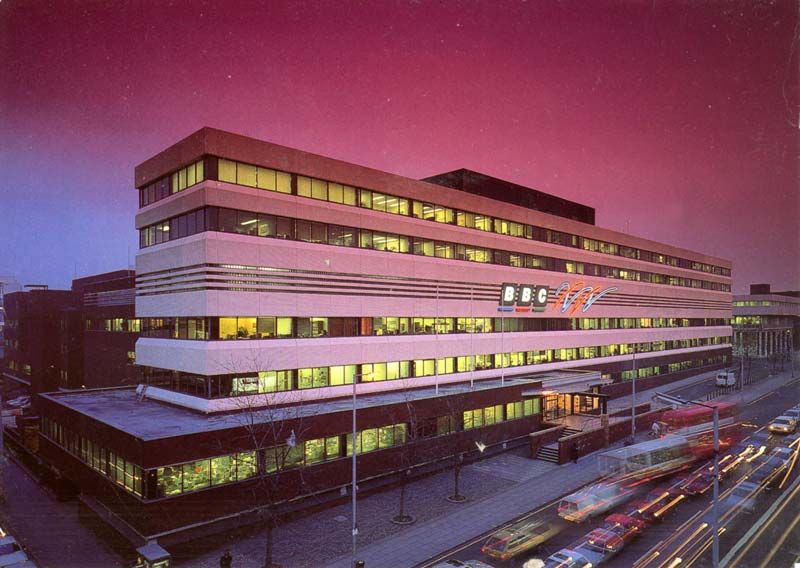
To be more specific: Red Dwarf was shot in Studio A at Oxford Road: the network production studio.1 Over the years, a great many nationally-broadcast programmes originated there; among others, the Oxford Road Show, A Question of Sport, Filthy Rich & Catflap, Cheggers Plays Pop, some editions of The Old Grey Whistle Test2, and a particular childhood favourite, The Satellite Show. And that’s only scraping the surface. Oxford Road Show aside, I expect plenty of viewers had no idea any of those series came from Manchester.
Still, for all the misinformation about Red Dwarf being shot at TV Centre, or having “no budget for any set”, the tales from the BBC tour guides were correct in one respect: certain scenes from the show really were shot on the lighting gantries in Studio A, standing in for the ship itself. Which is indeed an actual INTERESTING FACT.
Let’s take a look.
* * *
The very first time Red Dwarf used part of the studio to stand in for the ship itself was, appropriately enough, in its very first episode. Moreover, it’s one of the most famous scenes in the whole run of the show.
So in “The End” (TX: 15/2/88), as Holly tells Dave Lister that “everybody’s dead”, Lister takes a bit of a stroll across the lighting gantry in Studio A. From 0:38 in:
I’ve talked before about how over half of the first episode of Red Dwarf was reshot before transmission; that includes this scene, which was originally recorded entirely on the main studio sets. Here is that original version of the scene, as released on The Bodysnatcher Collection DVD set in 2007:
Now admittedly, that version of the scene doesn’t have a completed sound mix, and Craig Charles’ performance had got better between the two recordings. But even taking that into account, it’s easy to see how shooting on the lighting gantry gives the broadcast scene a sense of grandeur which is somewhat missing from the original. What better way to indicate exactly how shooting scenes in this way added to the show?
With the most famous example out of the way, what’s striking to me is how often the series pulled this trick, once you actually start looking for it. In the very next episode broadcast, “Future Echoes” (TX: 22/2/88), we get a sense of how a quick run across the lighting gantry can provide a nice bit of action without the expense of going on location:
John Pomphrey’s lighting is even more striking than usual in this shot. Fairly certain Craig running down those stairs like that breaks every Health and Safety reg going, mind.
Next up, “Waiting for God” (TX: 7/3/88) shows how a trip down to the bowels of the ship is made far more believable with a bit of gantry action:
And finally on this subject, let’s skip ahead a couple of series to “Bodyswap” (TX: 5/12/89):
The interesting thing about this example: at the start of Series III, Red Dwarf had a complete visual revamp in terms of its sets.3 Paul Montague was out as production designer, and Mel Bibby was in. Meaning that model shots aside, the above scene is by far the closest link Series III has visually to those first two series. It’s the only scene from Series III which could be credibly described as taking place in the exact same part of the ship as a Series 1 episode, or looking in any way like an episode from a previous series.
* * *
But for my money, the very best use of the existing architecture of Studio A was in Series 1’s “Confidence & Paranoia” (TX: 14/3/88). One scene calls for a spacewalk on the outside of the ship… and one of the most impressive sequences in production terms ended up using the infrastructure of the studio in an extremely ingenious way.
Of course, the main part of that sequence is just a (fantastic) set created on the studio floor. But what about the shot at the beginning, the wide of the ship with Lister and Confidence walking down the stairs?
Again, we have to go back to The Bodysnatcher Collection release – specifically, the documentary on Series 1, The Beginning – for the full story. Lighting director John Pomphrey reveals all:
JOHN POMPHREY: Paul [Montague] designed the set against the sound gallery wall, and the stairs that they came down were the actual stairs from the sound gallery… and dropped them in on the edit into a bigger shot.
And brilliantly, the documentary actually shows us behind-the-scenes footage of how this was achieved:
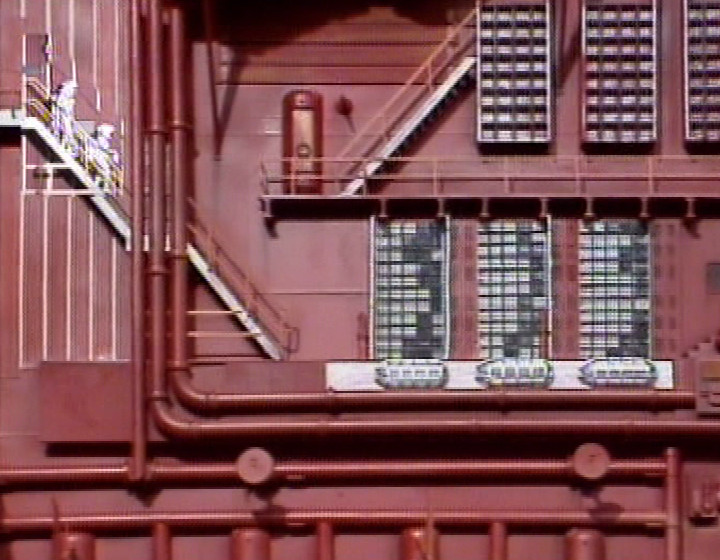
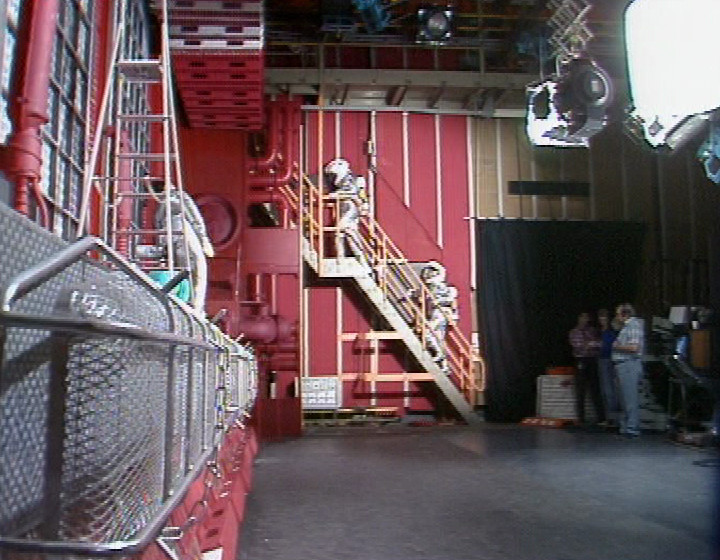
One thing I really love about this is that it isn’t just the stairs which became part of Red Dwarf itself. The distinctive vertically striped wall in Studio A was covered in red, and also became part of the ship’s hull. There’s no greater example of how the fabric of Oxford Road became part of Red Dwarf; both the show, and the actual ship.
* * *
Finally, I want to solve a little mystery. It’s a mystery which may have existed purely in my own head, but that counts, dammit.
So: where exactly was this scene from “Kryten” (TX: 6/9/88) shot?
For years, I had no idea. Checking the DVD cast commentary for the above scene, we get the following:
CRAIG CHARLES: This is filmed up in the Gods, right, the gantry, at the BBC studios… and actually, we weren’t supposed to be up here.
NORMAN LOVETT: It looks great.4
For years, I dismissed this. It didn’t look anything like the lighting gantry shots we’ve seen previously in this article. I thought Craig was just mistaken – which, to be fair, does happen on the cast commentaries – and that the scene was shot elsewhere at BBC Manchester. Maybe in a basement or something.
But no. Craig was, in fact, closer to the truth than I ever suspected. With thanks to Keith Jacobsen, who worked on Series 2 of Red Dwarf, I now know exactly where this scene was recorded. It’s right at the top of Studio A; above the lighting rig, and directly above the lighting gantries we saw earlier in this article. That machinery to the left of the shot is the motors for the hoists. And apparently, you really didn’t want to drop your keys down that grid – they’d land straight onto the studio floor below.
This space also appears in two other episodes of Dwarf; in a scene set during the pre-accident days in “Stasis Leak” (TX: 27/9/88), and Rimmer’s forced jog in “Queeg” (TX: 4/10/88):
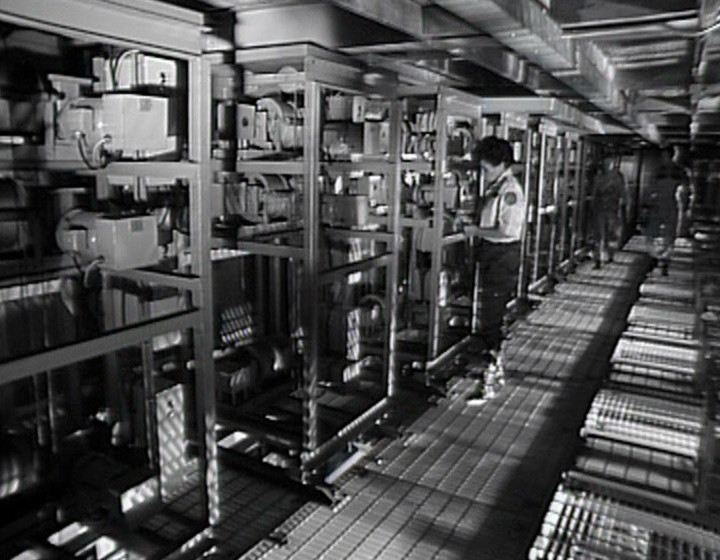
Stasis Leak
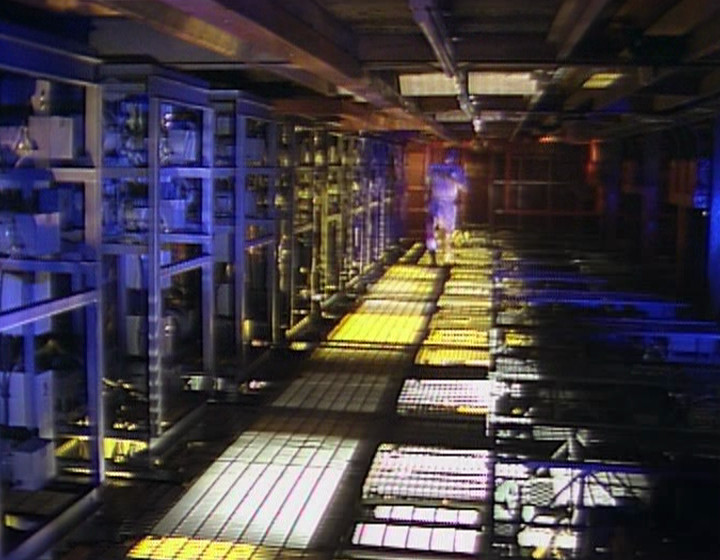
Queeg
At this point when researching this article, I had a little luck. For many years, the BBC published BBC Engineering, a publication which provided “a record of BBC technical experience and developments in radio and television broadcasting”. And the March 1976 edition goes into great depth about a certain brand new BBC facility which was officially opening that year.
And among the thrilling tech specs, floor plans, and photos of control rooms, we also get a picture of a rather familiar part of Studio A.
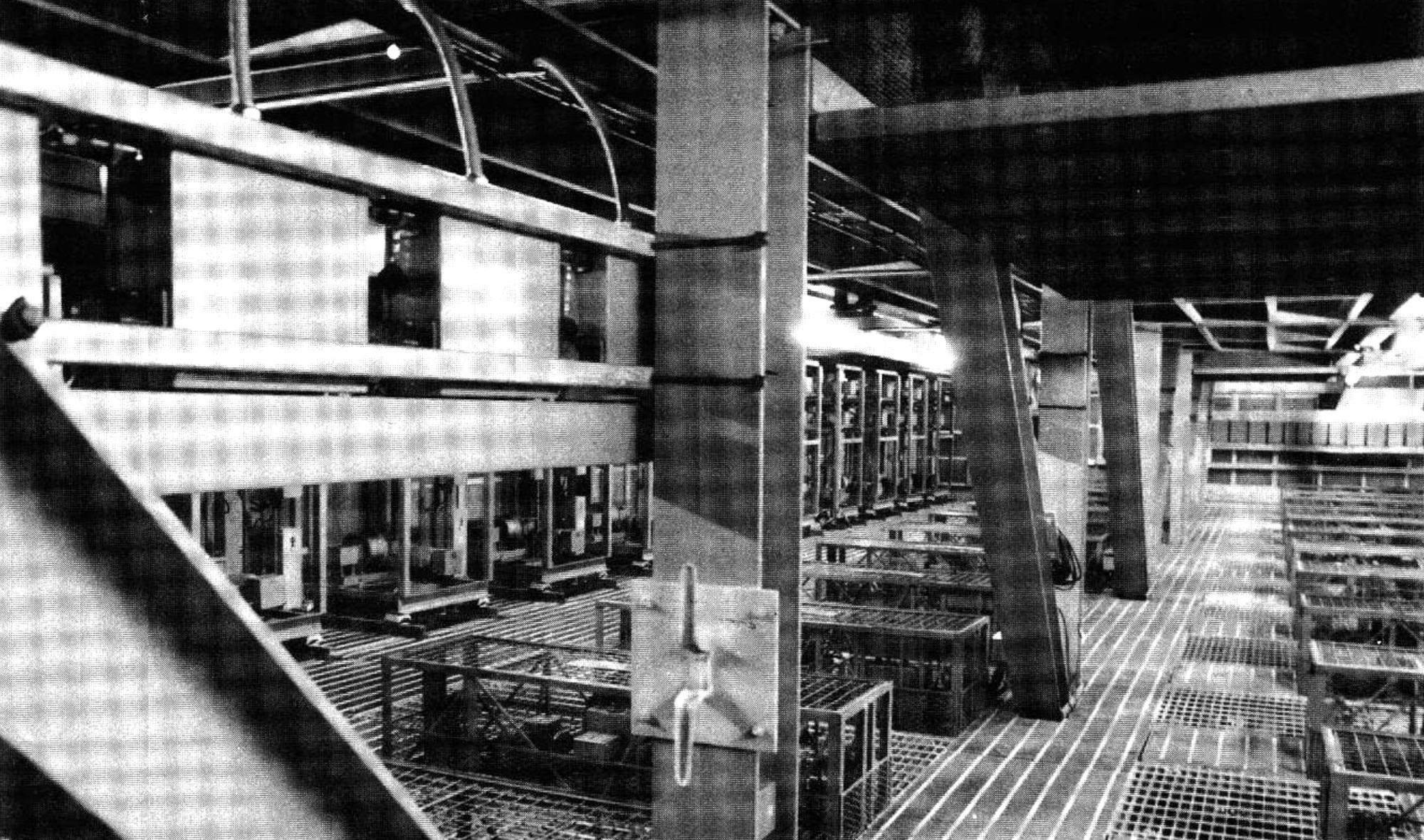
“The uncluttered lighting grid with lighting hoists on the floor and scenery hoists on the wall. Top right is one of the four air supply ducts for the studio”.
Phwwwoorrrrrrrrrrrr.
* * *
Red Dwarf left Manchester after Series III in 1989, after 18 episodes had been made there. The following year, Series IV was recorded in Shepperton, where the show remained for over two decades, until Series X.5 The kind of fun detailed in this article decreased a little over these years, partly because a sound stage simply has fewer interesting nooks and crannies to shoot in compared to a TV studio. Episodes like “The Inquisitor” in Series V would end up going on location to places like Sunbury Pumphouse in order to shoot action scenes set on Red Dwarf itself.
There was the odd exception, however. By far my favourite example is in “Fathers & Suns” (TX: 11/10/12) from Series X, where the staircase at the end of Shepperton Stage K doubles as the exit to Red Dwarf’s ramscoop:
As for Studio A at New Broadcasting House, it closed for refurbishment near the end of 1989, making Red Dwarf one of the last productions in the studio for 18 months. When it reopened in April 1991, as well as being the proud owner of brand new cameras and the like, it was also considerably larger than before, having grown from 66 x 53ft, to 94 x 66ft. This was a very useful space indeed – the biggest BBC studio outside London at the time – and the future of Studio A was surely assured for decades to come.6
Which makes its ultimate fate so sad. The refurbished studio lasted nine years; it was closed in 2000. A few years later, it was reopened and used as a sound stage for drama rather than a TV studio; Life on Mars was recorded there, among other shows.7 But Oxford Road’s days as a whole were coming to an end, not just Studio A. The last TV broadcast from New Broadcasting House was an edition of North West Tonight in Studio B on the 26th November 2011; the next day, the show started broadcasting from MediaCityUK.
In 2012, the building was demolished.
And that is the unfortunate irony about this whole business. This article started with a “fact” about Red Dwarf using TV Centre’s lighting gantries. It was mentioned by Londonist, when rumours first started swirling about the sale of TVC. And it was told to me in 2013, when I went on one of the last tours of the building before it closed. In other words: it was sold as an anecdote which meant something, about a building which was about to be, if not entirely demolished, then at least irreparably transformed into something entirely different.
But in 2012, the real studio that those gantries belonged to really was destroyed. We were sold a fake tale of destruction, when there was a real one which was being ignored. Indeed, as I was wandering around TV Centre in 2013, being told this warped and misunderstood tale, those famed gantries as seen in Red Dwarf had already gone. And if the loss of those studios at Oxford Road was already upsetting, then their on-screen adventures being misrepresented as a TV Centre anecdote instead was a final, unnecessary twist of the knife.
So if the above corrects the record, then I’m glad. And despite the destruction of Oxford Road, there is still something positive we can glean from all this. Because yes, all the shots of lighting gantries and the like above tickle a particular part of my brain that maybe I shouldn’t bring out in polite company. But I do love that embedded in early Red Dwarf is a part of those now long-demolished studios. Shards of their physical presence, popping up when you least expect it. A staircase here, a lighting hoist there.
A show which is seen worldwide, which will still be watched by people for decades to come… and yet a piece of it will forever be a snapshot of late 80s BBC Manchester. And to me, that really does mean something. A glimpse of the old BBC which is now just dust, sent out into the stars.
Preservation comes in many different forms. Even entirely unintentional ones.
Studio B was the smaller regional production studio, although this was also used for some daytime network programming such as Open Air and Daytime UK. ↩
I have to be honest, before researching this article, I thought that The Old Grey Whistle Test always came from TV Centre. But no. Here’s one of the first television performances by Dire Straits, transmitted live from Manchester’s Studio A. ↩
Well, more or less. ↩
This is a rare example of Norman Lovett saying something nice, out there in the wild. Treasure it. ↩
The show moved to Pinewood from 2015 onwards for Series XI, XII and The Promised Land. Cetain inserts for Red Dwarf Night in 1998 were shot at Teddington. ↩
All this information comes from the quite amazing History of Television Studios site by Martin Kempton, which I highly suggest you spend many hours browsing. ↩
“Life on Mars and Red Dwarf were shot in the same studio” is one of my favourite TV facts. ↩

3 comments
Rob on 22 July 2021 @ 12pm
Many thanks for this. As a local, it was such a shame to see the Oxford Road studios being demolished, especially after witnessing the refurb and expansion so soon beforehand. With Granada/ITV also abandoning their nearby studios, for a site just the other side of the canal from MediaCityUK, it does feel like an abandonment of TV production in Manchester.
It is wonderful, however, to see some small bits of the studio, that viewers never normally see, preserved forever ..
Chris Knight on 22 July 2021 @ 6pm
Thanks for another fascinating article. I’ve long been a fan of Red Dwarf, ever since it started airing in Canada way back at the tail end of the 80s. Always loved the series’ rough-and-ready look – never realized some of the “sets” were just what they had at hand. And your use of clips is perfect!
John J. Hoare on 20 June 2023 @ 2pm
Just amended this article in order to remove a section about a scissor lift, which I can’t quite figure out whether was at Oxford Road, or the Beeb’s Liverpool studios. In the absence of proof either way, it’s neater just to get rid of the section entirely.